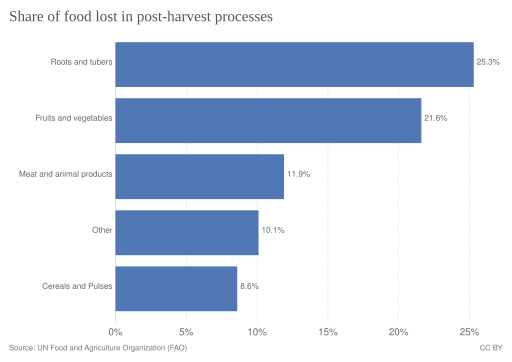In the journey from farm to fork, a staggering amount of food is lost. Not only is food waste a massive humanitarian concern, what with almost three billion people unable to afford a healthy diet, but the energy, water and other resources spent on producing the food are also squandered.
What’s more, that wasted food doesn’t just disappear into thin air. Discarded food decays in vast landfills, releasing tonnes of methane, a greenhouse gas at least 28 times more potent than CO2 at heating our planet. The WWF assessed that somewhere between six and eight percent of human-caused greenhouse gas emissions could be reduced if we stopped wasting food.
“You can’t manage what you can’t measure”
In order to tackle the issue, the International Finance Corporation (IFC) has partnered with the Carbon Trust to develop a way to measure and mitigate food loss. The Food Loss Climate Impact Tool is the first of its kind. It estimates the greenhouse gas (GHG) emissions caused by food waste, enabling businesses involved along the agricultural food chain to identify critical intervention points.
And, as with all businesses, money talks. Vitally, the tool also calculates the cost savings associated with reducing these losses, meaning users are presented with both the environmental and concurrent financial costs associated with food loss within their supply chains.
How the Food Loss Climate Impact Tool works
The tool itself is delightfully simple. It’s an Excel spreadsheet created using open-source data to provide clear and detailed reports on GHG emissions. These are categorised by each phase of the value chain, all the way from production and transport to storage, through to processing, retail and, then, eventually landfill. It’s comprehensive; 50 different crops and animal products across 117 countries are trackable.
“We focused on how we could provide quick and accurate estimates of the climate impact of food losses and waste along the food value chain” Marcello Gatti, Climate Risk and Strategy Technical Lead at the Carbon Trust, told RESET. However, this is not always a straightforward task, particularly in contexts with limited data availability, such as the Global South.
“To ensure its effectiveness, the tool is designed with built-in default values tailored to specific countries and commodities. These defaults allow the tool to generate estimates even in the absence of local data, ensuring it can be used effectively across diverse contexts.”
Collaboration can be complicated
Its accuracy and reliability have also been ensured through peer reviews by the Food and Agriculture Organization (FAO) and Cranfield University. Indeed, the tool has been developed in collaboration with some of the world’s largest institutions, which has meant strong financial backing. However, this often means that the loudest voices—typically those with the largest wallets—get their voices heard first. Large banks and financial institutions funding projects tend to look at solutions from a financial perspective, which can come at the expense of “greener solutions, [which] are not always the most financially viable.”
However, Gatti is pleased with the partnerships that supported the Food Loss Climate Impact Tool’s development. “We developed the tool in partnership with the International Finance Corporation (IFC), part of the World Bank Group and the largest global development institution focused on the private sector in emerging markets. [They] provided us with the overall requirements and objectives for the tool, while we used our expertise to develop the methodology and technical components.”
“Through my work with the IFC, I’ve seen their continuous efforts in developing frameworks that help investment officers navigate complex challenges. I believe this shows [a] commitment to [supporting] vulnerable communities and [addressing] sustainability concerns.”
In equipping businesses with the knowledge needed to make informed decisions, the tool represents a potential step forward towards a more sustainable and equitable global food system.
The post Reducing Food Waste With the Food Loss Climate Impact Tool appeared first on Digital for Good | RESET.ORG.


